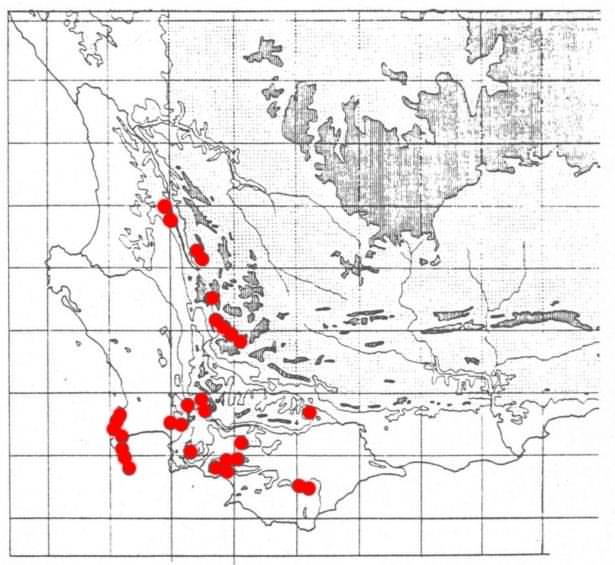(L.) Kuntze
Picture to follow
Characteristics of the Gerbera Crocea:
Roots 1-3 mm wide. Leaves 3.5-35 cm long, 2-7.5(8.2) cm wide. Petiole (1-)2-15 cm long, 1-3 mm wide, up to 10 mm at the base, light pilose-villose (sometimes sparsely) or now and then thick, felted-cob
webby pilose-tomentose, later more or less glabrous. Blade 2.5-23 cm long, elliptic-oblong, ovate or obovate, rarely broadly lanceolate; apex obtuse, base truncate to somewhat decurrent; margin varying from entire to irregularly sinuate with even or rounded, regular to irregular incissions, more or less crenate-toothed, glabrous to pilose. Upper surface rather dull green and hardly shiny, generally glabrous, but sometimes slightly pilose to cobwebby pilose-villose with light hairs; lower surface varying from thinly whitish-greyish tomentose to glabrous, hairs decaying with age.
Scapes 1-3(-8), 15-60(-75) cm long, 1-3 mm wide, felted-pilose with greyish or often yellowish-brown, short hairs or glabrous, at least when older. Bracts often quite numerous, usually about 10 mm long. Involucral bracts (4-)5-17(-19) mm long, 0.75-3 mm wide, from almost glabrous to moderately greyish pilose on the outside.
Heads 12-23 mm long, 20-35 mm wide. Ray florets very variable in colour: pink or white, sometimes mauve, crimson, maroon, cream, reddish, magenta, purplish or yellowish-purple, in other cases white above, red-maroon to brownish-coppery below, or pinkish to mauve above, more dark below. Tube 3-Q mm long, lower limb 10-30 mm long, 2-5 mm wide, upper limb 2-4 mm long, style 1.5-3.5 mm long. Disc florets reported as yellow or purple, tube 4-8 mm long, limbs 2.5-3.5 mm long.
Achenes 6.5-7.5 mm long inclusive a sub-beaked part 1-2 mm long.
Pappus snow-white, more rarely whitish to whitish tawny.

Distribution: Gerbera Crocea can be found from the Cape Peninsula and eastwards to around Montagu and Bredasdorp -and as far northwards – as around Clanwilliam. 301900ma.s.l.
Ecology: On hills and slopes, in stony and rocky, sandy soil, often on recently burnt ground, rarely in moist habitats; quite common.
Flowering season: Throughout the year, but mainly from Oct.-Jan. (Sept.-May).
Gerbera Crocea includes forms with entire, dentate or sinuate leaves, glabrous or sparsely to softly, densely, whitishgreyish tomentose below. Although forms with sinuate leaves generally have an abaxial leaf tomentum, there are transitions to forms without this tomentum, and no varieties can be distinguished on such characters.
G. crocea is generally easily distinguished by the snowwhite pappus; however, about 10 per cent of the specimens have whitish-tawny pappus bristles. Some of them have totally glabrous leaves with entire margins; Harvey (1865) referred them to the species G. integralis. But actually this group often has an indistinctly dentate leaf margin. The specimens of it tendence to have pure white rays and to grow in moist habitats, while Gerbera Crocea forms with snow-white pappus often have white/red to red rays and almost always grow in dry areas, but in all cases there are transitions and thus no justification for accepting G. integralis at all.
It appears that the snow-white pappus cannot be used as a diagnostic character of G. crocea this corresponding to the conclusion in sect. Lasiopus. Still most specimens are easily recognized by this trait and also by the either glabrous or thinly tomentose subsurfaced leaves; in the latter case the leaf margin is more irregularly sinuate than in the other species. Brownish hairs occur sometimes as a felted (but not woolly) tomentum in the upper part of the scape.
The leaf base is always cuneate or slightly decurrent. Yellow rays have not been reported, but rarely yellow tints have been claimed. From a morphological point of view G. crocea is closer to G. wrightii than to the other species of the genus.
The species has often been named G. burmanni Dc., probably due to the great importance of the Prodromus. All forms of Gerbera Crocea are present in Herb. LINN under A. Crocea.

Source: Opera Botanica 78 1985
Return to the top of Gerbera Crocea
